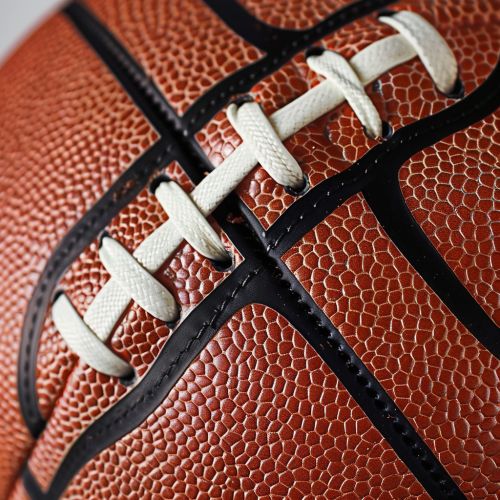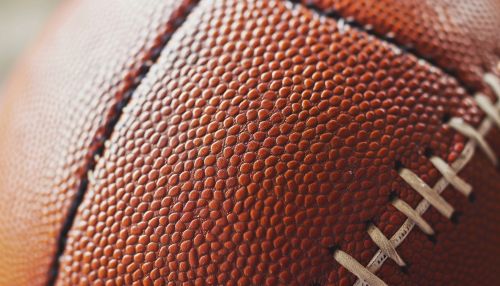Football Design: Difference between revisions
No edit summary |
No edit summary |
||
| Line 22: | Line 22: | ||
The bladder is the innermost component of a football and is responsible for holding air. Modern footballs use latex or butyl bladders. Latex bladders offer superior elasticity and responsiveness, while butyl bladders provide better air retention. | The bladder is the innermost component of a football and is responsible for holding air. Modern footballs use latex or butyl bladders. Latex bladders offer superior elasticity and responsiveness, while butyl bladders provide better air retention. | ||
[[Image:Detail-79365.jpg|thumb|center|Close-up of a modern football, showing the textured synthetic leather cover and stitching.]] | [[Image:Detail-79365.jpg|thumb|center|Close-up of a modern football, showing the textured synthetic leather cover and stitching.|class=only_on_mobile]] | ||
[[Image:Detail-79366.jpg|thumb|center|Close-up of a modern football, showing the textured synthetic leather cover and stitching.|class=only_on_desktop]] | |||
== Aerodynamics of Football Design == | == Aerodynamics of Football Design == | ||
Latest revision as of 06:04, 18 May 2024
Introduction
Football design is a multifaceted discipline that encompasses the creation, development, and optimization of footballs used in various forms of the sport. This involves a deep understanding of materials science, aerodynamics, and manufacturing processes to produce footballs that meet the stringent requirements of professional leagues and international competitions. The design of a football significantly impacts its performance, durability, and the overall experience of the game.
Historical Evolution of Football Design
The design of footballs has evolved considerably since the sport's inception. Early footballs were made from animal bladders, which were inflated and covered with leather. These rudimentary balls were prone to irregular shapes and inconsistent performance. The introduction of rubber bladders in the 19th century marked a significant advancement, providing more uniformity and better control.
The modern era of football design began in the mid-20th century with the advent of synthetic materials. The 1970 FIFA World Cup saw the introduction of the first synthetic leather football, the Adidas Telstar, which set new standards for durability and performance. Since then, football design has continued to evolve, incorporating advanced materials and technologies to enhance the game's quality.
Materials Used in Football Design
The choice of materials is crucial in football design, as it directly affects the ball's performance, durability, and feel. Modern footballs typically consist of the following components:
Outer Cover
The outer cover of a football is usually made from synthetic leather, which is a blend of polyurethane (PU) and polyvinyl chloride (PVC). Synthetic leather offers several advantages over natural leather, including better water resistance, durability, and consistent performance. The outer cover is often textured to improve grip and control.
Inner Lining
Beneath the outer cover, multiple layers of polyester or cotton fabric are used to provide structure and support. These layers, known as the inner lining, help maintain the ball's shape and enhance its durability.
Bladder
The bladder is the innermost component of a football and is responsible for holding air. Modern footballs use latex or butyl bladders. Latex bladders offer superior elasticity and responsiveness, while butyl bladders provide better air retention.


Aerodynamics of Football Design
The aerodynamics of a football play a critical role in its flight characteristics. Factors such as shape, surface texture, and panel configuration influence how the ball moves through the air.
Shape and Symmetry
A perfectly spherical shape is essential for consistent flight behavior. Any deviations from this shape can cause unpredictable movements, known as "knuckling." Modern manufacturing techniques ensure that footballs are as close to a perfect sphere as possible.
Surface Texture
The surface texture of a football affects its interaction with the air. A smooth surface can lead to erratic flight patterns, while a textured surface helps stabilize the ball's trajectory. The texture is often achieved through embossing or adding micro-textures to the outer cover.
Panel Configuration
Traditional footballs consist of 32 panels stitched together. However, recent designs have experimented with fewer panels to reduce the number of seams and improve aerodynamics. For example, the Adidas Brazuca, used in the 2014 FIFA World Cup, features only six panels.
Manufacturing Processes
The manufacturing process of a football involves several stages, each critical to ensuring the final product meets quality standards.
Cutting and Shaping
The first step is cutting the synthetic leather into panels. These panels are then shaped and prepared for assembly. Precision cutting is essential to ensure uniformity and consistency.
Stitching and Bonding
Panels are either stitched or thermally bonded together. Stitched footballs are traditional and offer a classic feel, while thermally bonded footballs provide better water resistance and a more consistent surface.
Bladder Insertion
The bladder is inserted into the assembled panels, and the ball is inflated to check for leaks and ensure proper shape. This step is crucial for maintaining air retention and overall performance.
Quality Control
Each football undergoes rigorous quality control tests, including weight, circumference, rebound, and water absorption tests. Only balls that meet the required standards are approved for use in professional competitions.
Innovations in Football Design
Recent innovations in football design focus on enhancing performance, durability, and sustainability.
Advanced Materials
Researchers are exploring new materials, such as graphene and carbon fiber composites, to create lighter and more durable footballs. These materials offer superior strength-to-weight ratios and improved performance characteristics.
Smart Footballs
The integration of sensors and electronic components into footballs has led to the development of smart footballs. These balls can track data such as speed, spin, and trajectory, providing valuable insights for players and coaches.
Sustainable Design
Sustainability is becoming increasingly important in football design. Manufacturers are exploring eco-friendly materials and processes to reduce the environmental impact of football production. For example, some companies are using recycled materials for the outer cover and inner lining.
Conclusion
Football design is a complex and dynamic field that combines materials science, aerodynamics, and manufacturing expertise to create high-performance sports equipment. The continuous evolution of football design ensures that the game remains exciting and enjoyable for players and fans alike.
